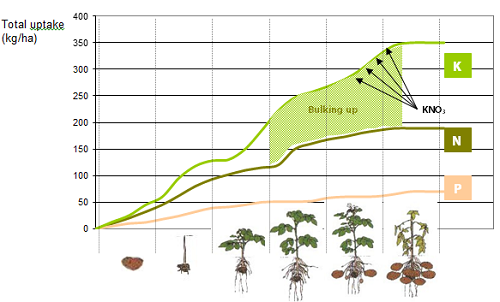Balanced nutrition for productive potatoes
With harvesting under way in potatoes, now is a good time to start planning your nutrient requirements for the next crop. This starts with soil testing to understand the nutrients available in the soil and limitations to be addressed.
Conrad Leeks, Technical Agronomist Horticulture, Incitec Pivot Fertilisers
Download this article
Getting crop nutrition right is a vital area of planning, but it can be a difficult balancing act for growers and their advisers. To keep nutrition in balance requires:
- soil testing to understanding initial soil fertility levels,
- a fertiliser program that matches crop demand, and
- tissue testing to address any in-crop nutrient deficiencies.
Soil testing
Soil testing helps understand what nutrients are present in the soil and the level of their availability to plants. Ideally, soil testing should be conducted at the same time each year, so the results can be used to monitor and improve soil health over time.
Soil sampling should be conducted several weeks prior to planting. At least 25 to 30 cores should be collected for each topsoil sample, to a depth of 0 - 15 cm. If there are areas in a paddock with different soils or different management strategies, they should be sampled and tested separately.
It is important to use a credible and accredited laboratory for soil testing. The Nutrient Advantage® laboratory is a major provider of soil, plant tissue and water analysis and is externally accredited by third-party parties such as the National Association of Testing Authorities (NATA) and Fertcare®. It also participates in the Australasian Soil and Plant Analysis Council’s (ASPAC) proficiency program.
A comprehensive soil test package for potato growers in southern Australia is Nutrient Advantage’s E13 test. It will provide results on all the macro nutrients, as well as the micronutrients (copper, iron, manganese and zinc) pH, texture, organic carbon, chloride levels and electrical conductivity. Having this information will help develop fertiliser recommendations tailored to individual crops.
Developing a fertiliser program
When choosing fertilisers for the crop, growers and their advisers need to consider the entire nutrient balance needed by the crop and the available nutrients from the soil. As shown in Table 1 below, soil nutrient availability can vary considerably, so a potato crop’s requirement for fertilisers will vary from season to season and in different soils.
For example, following the 2016 soil test result, a potato grower would need to apply significant rates of nitrogen and phosphorus at or before planting. Nitrogen drives crop growth and yield and without it, the grower would have little chance of a commercially acceptable yield. Phosphorus is crucial to enhancing early crop growth and tuber set, as well as promoting tuber maturity. Potato growers should be aiming to apply the full phosphorus requirement for the crop by planting time.
Similarly, following the 2017 results, nitrogen and phosphorus would be the priorities. However, a more balanced approach could be taken, with some potassium applied at planting as well. Large amounts of potassium are required in potatoes, as shown in Table 2.
Table 1: Soil test results from a commercial potato cropping system, Pinnaroo, SA
|
Nutrient |
2016 result |
2017 result |
||
|
Nitrate nitrogen |
2 mg/kg |
Very low |
5 mg/kg |
Very low |
|
Ammonium nitrogen |
8 mg/kg |
Low |
1 mg/kg |
Very low |
|
Phosphorus (Colwell) |
30 mg/kg |
Very low |
42 mg/kg |
Low |
|
Potassium |
85.8 cmol(+)/kg |
Low |
101.4 cmol(+)/kg |
Low |
|
Magnesium |
51.6 cmol(+)/kg |
Optimal |
118.8 cmol(+)/kg |
Optimal |
|
Sulphur |
32 mg/kg |
High |
181 mg/kg |
Very high |
|
Calcium |
208 cmol(+)/kg |
Very low |
722 cmol(+)/kg |
Optimal |
Table 2: Nutrient removal for a 50-tonne potato crop
|
Nutrient |
kg/ha removed |
kg/t tubers |
|
Nitrogen |
180 |
3.6 |
|
Phosphorus |
25 |
0.5 |
|
Potassium |
200 |
4 |
|
Magnesium |
15 |
0.3 |
|
Calcium |
10 |
0.2 |
|
Sulphur |
20 |
0.4 |
Without soil testing it would be impossible to adjust the fertiliser program to take into account these differences and treat crops with the nutrition they need to reach their full potential. Because is no right answer to all potato crops’ nutrient requirements, Incitec Pivot Fertilisers offers a wide range of fertiliser compounds and blends. These include ammonium phosphate fertilisers, Granulock® fertilisers, urea and Nitrophoska® Special.
Nitrophoska Special is a balanced compound fertiliser which matches well with many potato crops’ early nutrient requirements. It contains 12% nitrogen, 5.2% phosphorus, 14.1% potassium, 8% sulphur, plus some magnesium, boron and zinc in every granule. It is very well suited for salt-affected soils as it includes chloride free potassium.
The granules are resin treated for free-flowing precise application and ease of storage. Nitrophoska Special can also be blended with other fertilisers to adjust the ratio of nutrients where required. For example, on low phosphorus fertility soils, growers may choose a blend of Nitrophoska Special and MAP.
Nutrition through the season
Good nitrogen management means placing fertilisers where the crop is best able to use them and timing applications for use during periods of greatest crop need, and this includes throughout the season. For example, on sandy soils where leaching may occur, applying large amounts of nitrogen immediately after planting may be inefficient. Nitrogen is needed most at tuber initiation and tuber bulking and can be topped up at these crop stages, to improve its use efficiency and to maximise potential yields.
As mentioned, potatoes require a lot of potassium. When applying large amounts of potassium, for example more than 400 kg/ha, it may be beneficial to plan for a side dress application six to eight weeks after planting. See Figure 1.

Figure 1: Macronutrient uptake during potato crop growth
Source: Harris, P. M. (1978). Mineral nutrition. In the Potato Crop (ed. Harris, P. M.), pp. 195–243. London: Chapman and Hall.Tissue testing is a good way to assess the crop’s nutrient status. Many potato growers use weekly or bi-weekly tissue testing to stay on top of plant nutrient requirements and adjust nutrition accordingly with in-crop applications.
The Nutrient Advantage laboratory provides tissue test results within three days of receiving samples. The basic plant tissue package (PT1) includes boron, calcium, copper, iron, magnesium, manganese, phosphorus, potassium, sodium, sulphur, zinc and nitrogen. Monitoring the crop with tissue testing completes the cycle started with soil testing and gives growers the opportunity to fertilise to correct any nutrient imbalances that could affect yield.
For more information on nutrition for potatoes, contact me on 0466 664 026 or conrad.leeks@incitecpivot.com.au.
Further information
Soil sampling and testing
Nitrophoska Special
https://www.incitecpivotfertilisers.com.au/~/media/Files/IPF/Brochures/Nitrophoska.pdf
®Nutrient Advantage and Granulock are registered trademarks of Incitec Pivot Limited. ®Fertcare is a registered trademark of Australian Fertiliser Services Association, Inc. ®Nitrophoska is a registered trademark of EuroChem Agro GmbH. Incitec Pivot Fertilisers is licensed to sell Nitrophoska Special in Australia. Incitec Pivot Fertilisers is a business of Incitec Pivot Limited ABN 42 004 080 264. This is a guide only, which we hope you find useful as a general tool. While Incitec Pivot Fertilisers has taken all reasonable care in the preparation of this guide, it should not be relied on as a substitute for tailored professional advice and Incitec Pivot Fertilisers accepts no liability in connection with this guide.


